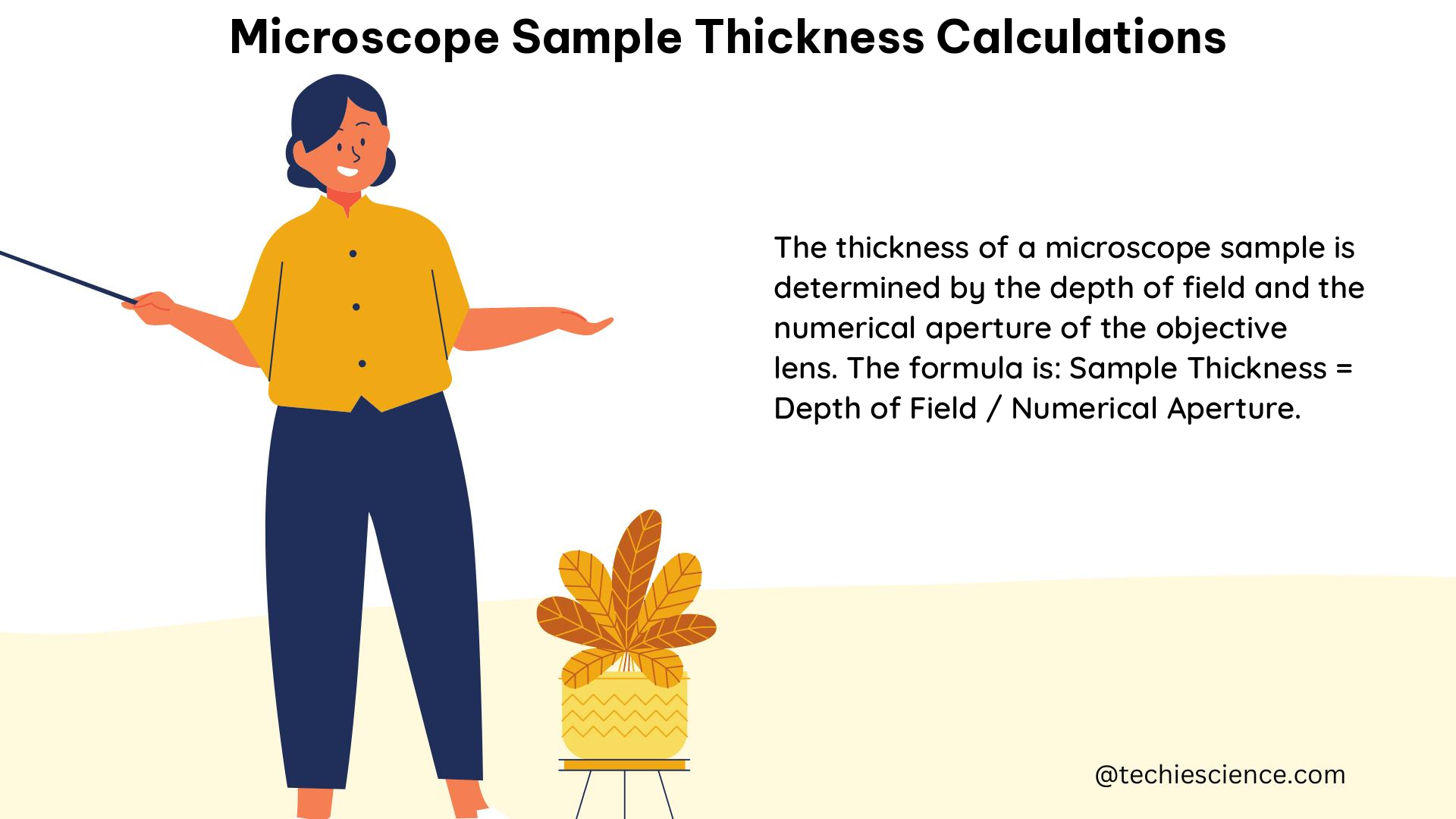Microscope sample thickness calculations involve various measurable and quantifiable data, including magnification, field of view, specimen size, and X-ray intensities for determining mass thickness and composition. This comprehensive guide will provide you with the necessary theoretical knowledge, formulas, examples, and numerical problems to master the art of microscope sample thickness calculations.
Magnification Calculations
The total magnification of a microscope is calculated by multiplying the magnification of the ocular lens by the magnification of the objective lens. This can be expressed mathematically as:
Total Magnification = Magnification of Ocular Lens × Magnification of Objective Lens
For example, if the ocular lens has a magnification of 10x and the objective lens has a magnification of 40x, the total magnification would be:
Total Magnification = 10x × 40x = 400x
This means that the specimen appears 400 times larger than its actual size when viewed through the microscope.
Field of View Calculations

The field of view (FOV) is the diameter of the circle of light seen through the microscope. It can be calculated by dividing the low power diameter by the high power magnification and multiplying by the low power magnification. The formula for this calculation is:
Field of View = (Low Power Diameter / High Power Magnification) × Low Power Magnification
For instance, if the high power magnification is 400x and the low power magnification is 40x, and the low power diameter is 8 mm, the high power diameter can be calculated as:
High Power Diameter = (8 mm / 400x) × 40x = 0.8 mm
Therefore, the field of view at the high power magnification is 0.8 mm.
Specimen Size Calculations
The specimen size is calculated by dividing the field of view by the number of specimens across the diameter. The formula for this calculation is:
Specimen Size = Field of View / Number of Specimens across Diameter
For example, if the field of view is 4 mm and 10 specimens can fit across the diameter, the specimen size would be:
Specimen Size = 4 mm / 10 = 0.4 mm
This means that each individual specimen has a size of 0.4 mm.
X-ray Intensity Measurements for Mass Thickness and Composition
In addition to the calculations mentioned above, other quantifiable data, such as the measurement of X-ray intensities in electron microscopy, can be used to determine the mass thickness and composition of the sample.
The intensity of silicon and nitrogen X-rays can be measured and compared with the intensities of X-rays produced within bulk elemental standards using an identical beam current. A thin film correction program can then iteratively calculate the mass thickness of the film and the concentrations of silicon and nitrogen therein.
The formula for this calculation can be expressed as:
Mass Thickness = f(X-ray Intensity Ratio, Beam Current, Elemental Composition)
where the mass thickness is a function of the X-ray intensity ratio, beam current, and elemental composition of the sample.
Example Calculation
Suppose we have a thin film sample with an unknown mass thickness and composition. We can measure the intensity of the silicon and nitrogen X-rays and compare them to the intensities of X-rays produced within bulk elemental standards using an identical beam current.
Let’s assume the following data:
– Measured Si X-ray Intensity: 1500 counts/s
– Measured N X-ray Intensity: 800 counts/s
– Bulk Si X-ray Intensity: 2000 counts/s
– Bulk N X-ray Intensity: 1200 counts/s
– Beam Current: 100 nA
Using the formula for mass thickness, we can calculate the mass thickness of the film:
Mass Thickness = f(X-ray Intensity Ratio, Beam Current, Elemental Composition)
Mass Thickness = f((1500/2000), (800/1200), 100 nA, Si, N)
Mass Thickness = 0.75 × 0.667 × 100 nA × (Si, N)
Mass Thickness = 50 ng/cm^2
This calculation provides an estimate of the mass thickness of the thin film sample, which can be further used to determine the concentrations of silicon and nitrogen within the film.
Additional Resources
For further reading and examples on microscope sample thickness calculations, please refer to the following resources:
Reference:
– Microscope Magnification and Field of View Calculations
– Scanning Tunneling Microscopy
– Thin Film Thickness Measurement
– Electron Microscopy Techniques for Nanomaterials Characterization
– Transmission Electron Microscopy
By understanding the theoretical concepts, formulas, and practical examples provided in this guide, you will be well-equipped to perform accurate microscope sample thickness calculations and apply them in your physics research and experiments.

The lambdageeks.com Core SME Team is a group of experienced subject matter experts from diverse scientific and technical fields including Physics, Chemistry, Technology,Electronics & Electrical Engineering, Automotive, Mechanical Engineering. Our team collaborates to create high-quality, well-researched articles on a wide range of science and technology topics for the lambdageeks.com website.
All Our Senior SME are having more than 7 Years of experience in the respective fields . They are either Working Industry Professionals or assocaited With different Universities. Refer Our Authors Page to get to know About our Core SMEs.